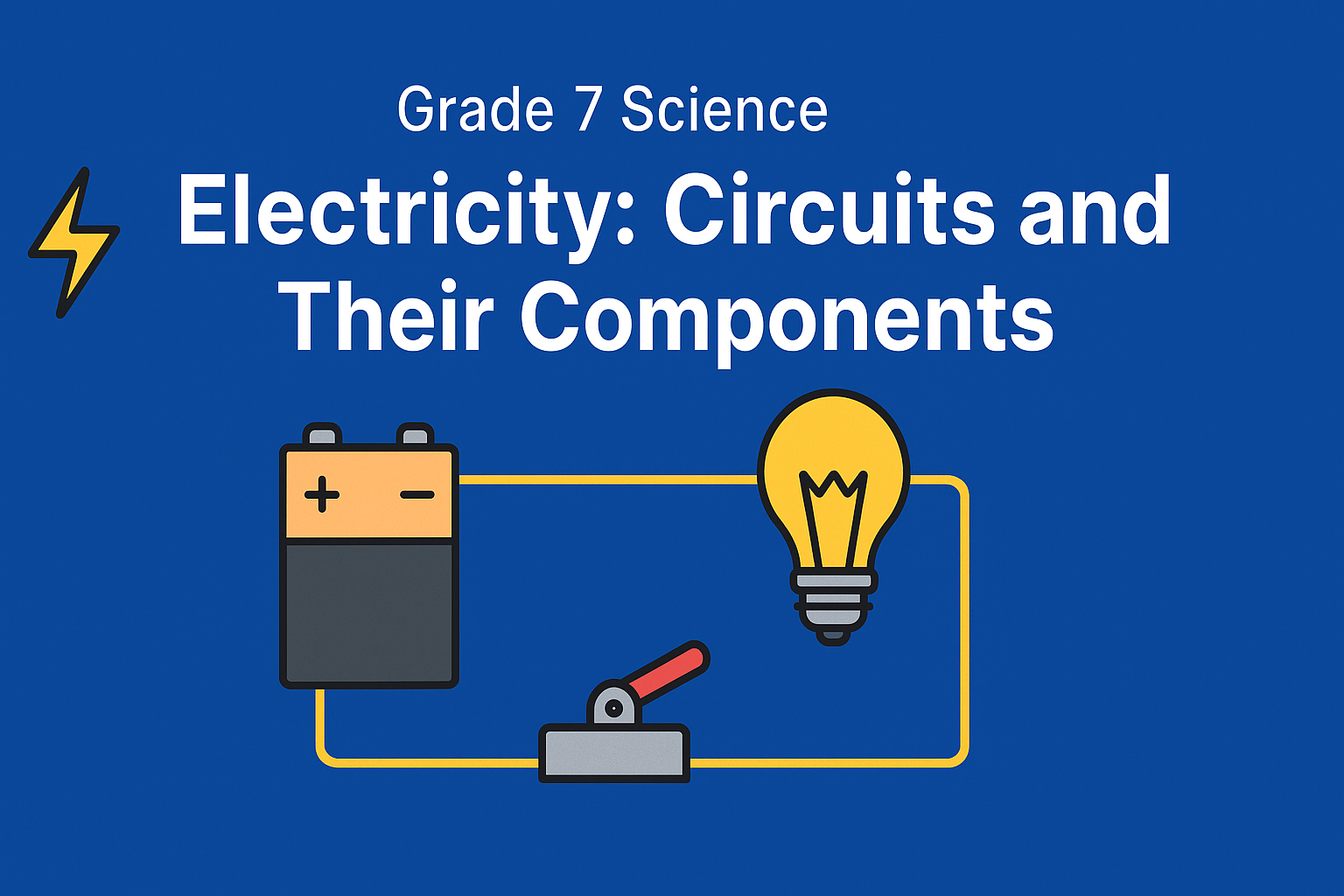📚 Grade 7 Science – Easy Summary

- 📚 Grade 7 Science – Easy Summary
- 🔍 Introduction to Electricity
- 🔋 What is an Electric Cell?
- 💡 Lamps and LEDs in Circuits
- 🔥 Incandescent Lamp
- 🔆 LED (Light Emitting Diode)
- 🔁 Understanding Electric Circuits
- 🧪 Fun Fact:
- 🔘 Role of Switches in a Circuit
- 📊 Circuit Diagrams and Their Symbols
- ✅ Common Electrical Symbols:
- ⚙️ Conductors vs Insulators
- ⚡ Conductors:
- 🚫 Insulators:
- 🔍 Let’s Revise the Key Concepts (Quick Recap)
- 🔬 Real-Life Applications of Electricity
- 🛠️ Simple Activities You Can Try at Home
🔍 Introduction to Electricity
Electricity is a powerful form of energy that runs almost everything around us — from lights and fans to mobile phones and trains. In this chapter explanation, we explore how electricity works, what electric circuits are, and how components like cells, batteries, wires, switches, and lamps help complete a circuit. This chapter explanation will take you through essential concepts of electricity.
Understanding this chapter explanation is crucial for mastering the basics of electricity.
In this chapter explanation, we will also discuss the significance of electric cells in our daily lives.
In summary, this chapter explanation is vital for building a solid foundation in electricity.
🔋 What is an Electric Cell?
An electric cell is a small portable device that produces electricity.
- It has two terminals:
✔️ Positive terminal (+) – metal cap
✔️ Negative terminal (–) – flat base - We often use more than one cell together. This arrangement is called a battery.
🔄 In a battery, always connect the positive terminal of one cell to the negative terminal of the next.
Watch the Video Explanation/Chapter Summary in Easy words Here
💡 Lamps and LEDs in Circuits
🔥 Incandescent Lamp
- Used in older torchlights.
- Has a filament that glows when electricity passes through it.
- Two terminals: tip and metal case.
🔆 LED (Light Emitting Diode)
- Found in modern torches.
- Has no filament.
- One-way component:
- Longer leg → Positive terminal
- Shorter leg → Negative terminal
❗ An LED only glows if connected correctly to the battery.
🔁 Understanding Electric Circuits
A circuit is a complete path for electric current to flow.
- If the path is complete (closed) → Current flows → Lamp glows.
- If the path is open or broken → No current → Lamp does not glow.
🧪 Fun Fact:
If a bulb’s filament breaks, we say it is fused. A fused bulb does not glow even in a complete circuit.
🔘 Role of Switches in a Circuit
A switch is a device that turns a circuit ON or OFF.
- Switch ON = Circuit is closed = Electricity flows
- Switch OFF = Circuit is open = No current
You can even make a simple switch at home using:
- A cardboard piece
- A safety pin
- Drawing pins and wires
📊 Circuit Diagrams and Their Symbols
To make circuits easier to understand, we use symbols to draw them.
✅ Common Electrical Symbols:
| Component | Symbol Description |
|---|---|
| Cell | Long + short line (+ / –) |
| Battery | Multiple cells in a row |
| Lamp | Circle with a cross inside |
| Switch (ON) | Line connected (closed loop) |
| Switch (OFF) | Line disconnected (open gap) |
| LED | Triangle with arrows |
🧠 These symbols are used worldwide in textbooks and real-life electrical diagrams.
⚙️ Conductors vs Insulators
Some materials allow electricity to pass, while others do not.
⚡ Conductors:
- Allow electric current to pass.
- Examples: Copper, Aluminium, Iron, Human Body
- Used in: Wires, switches, plugs
🚫 Insulators:
- Do not allow electric current to pass.
- Examples: Plastic, Rubber, Glass, Wood
- Used to cover wires for safety.
We recommend revisiting this chapter explanation whenever you need a refresher.
As we delve deeper into this chapter explanation, we will uncover interesting facts about how switches operate.
⚠️ Safety Tip: Never touch electric switches or wires with wet hands. Water conducts electricity!
Engaging with this chapter explanation prepares you for more complex concepts.
🔍 Let’s Revise the Key Concepts (Quick Recap)
- 🔋 An electric cell provides power to a circuit.
- 🔗 A battery is two or more cells connected properly.
- 💡 A lamp glows when electricity flows through its filament or LED.
- 🔁 A circuit must be complete for the lamp to glow.
- 🔘 A switch controls the flow of current.
- 🔄 LEDs work in one direction only.
- ⚡ Conductors allow current; insulators do not.
- ✍️ Use symbols to draw circuit diagrams.
🔬 Real-Life Applications of Electricity
Electricity is used in many fields. Let’s group them:
| Use Case | Examples |
|---|---|
| Lighting | Homes, streets, shops, factories |
| Cooking | Toaster, microwave, induction stove |
| Cooling/Heating | Fan, AC, geyser, room heater |
| Entertainment | TV, Radio, Computer |
| Communication | Mobile phones, Internet |
| Transport | Train, electric bus, escalators, lifts |
Understanding these symbols is part of this chapter explanation’s goal to simplify learning.
🛠️ Simple Activities You Can Try at Home
In this chapter explanation, we’ll cover real-life applications of electricity in detail.
- 🔧 Build a simple circuit using a cell, wires, and a bulb.
- 🧪 Test which materials conduct electricity using a basic tester.
- ✂️ Make a DIY switch from cardboard and safety pins.
- 📝 Draw circuit diagrams using standard symbols.
🔌 Start observing electrical circuits around you – in torches, toys, remotes, and even your phone charger!
This chapter explanation will equip you with essential knowledge about electric circuits.
⚠️Beware of Cyber – Crime and Cyber – Fraudulent⚠️
